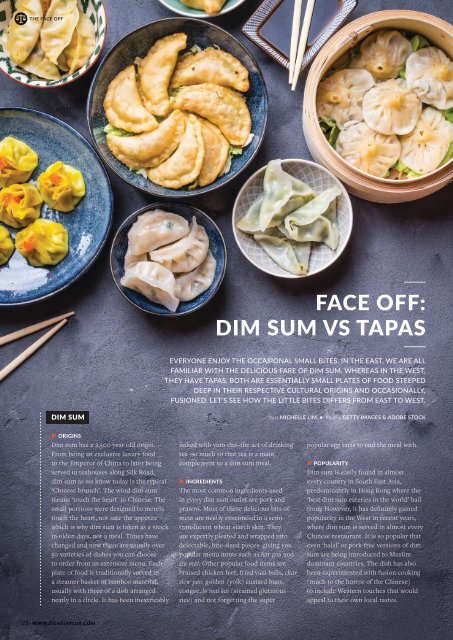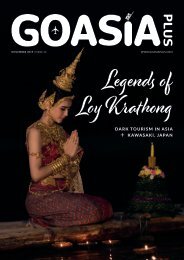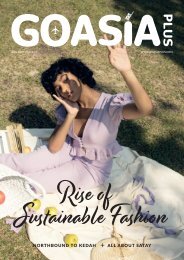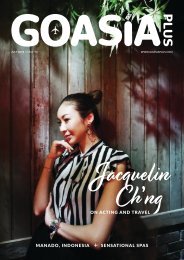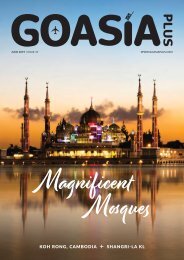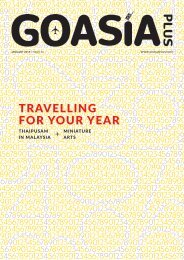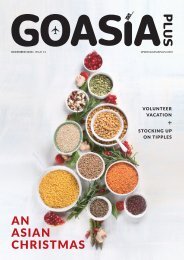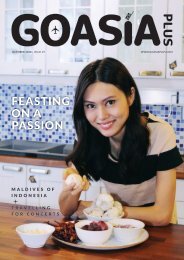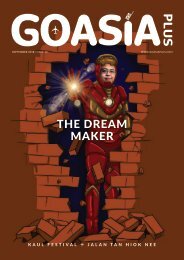GOASIAPLUS November 2018
See how travel can build acceptance towards diversity in our November issue through our main interview with Panasonic Managing Director, Mr Cheng. For this Single's Day, we present 11 places that are best for a solo traveller, street puppetry in Kuala Lumpur and unveiling Malaysia's hawker scene.
See how travel can build acceptance towards diversity in our November issue through our main interview with Panasonic Managing Director, Mr Cheng. For this Single's Day, we present 11 places that are best for a solo traveller, street puppetry in Kuala Lumpur and unveiling Malaysia's hawker scene.
You also want an ePaper? Increase the reach of your titles
YUMPU automatically turns print PDFs into web optimized ePapers that Google loves.
THE FACE OFF<br />
FACE OFF:<br />
DIM SUM VS TAPAS<br />
EVERYONE ENJOY THE OCCASIONAL SMALL BITES. IN THE EAST, WE ARE ALL<br />
FAMILIAR WITH THE DELICIOUS FARE OF DIM SUM. WHEREAS IN THE WEST,<br />
THEY HAVE TAPAS. BOTH ARE ESSENTIALLY SMALL PLATES OF FOOD STEEPED<br />
DEEP IN THEIR RESPECTIVE CULTURAL ORIGINS AND OCCASIONALLY,<br />
FUSIONED. LET’S SEE HOW THE LITTLE BITES DIFFERS FROM EAST TO WEST.<br />
DIM SUM<br />
Text MICHELLE LIM • Photos GETTY IMAGES & ADOBE STOCK<br />
ORIGINS<br />
Dim sum has a 2,500 year old origin.<br />
From being an exclusive luxury food<br />
to the Emperor of China to later being<br />
served in teahouses along Silk Road,<br />
dim sum as we know today is the typical<br />
‘Chinese brunch’. The word dim sum<br />
means ‘touch the heart’ in Chinese. The<br />
small portions were designed to merely<br />
touch the heart, not sate the appetite –<br />
which is why dim sum is taken as a snack<br />
in olden days, not a meal. Times have<br />
changed and now there are usually over<br />
50 varieties of dishes you can choose<br />
to order from an extensive menu. Each<br />
plate of food is traditionally served in<br />
a steamer basket of bamboo material,<br />
usually with three of a dish arranged<br />
neatly in a circle. It has been inextricably<br />
linked with yum cha–the act of drinking<br />
tea–so much so that tea is a main<br />
complement to a dim sum meal.<br />
INGREDIENTS<br />
The most common ingredients used<br />
in every dim sum outlet are pork and<br />
prawns. Most of these delicious bits of<br />
meat are neatly ensconced in a semitranslucent<br />
wheat starch skin. They<br />
are expertly pleated and wrapped into<br />
delectable, bite-sized pieces–giving you<br />
popular menu items such as har gou and<br />
siu mai. Other popular food items are<br />
braised chicken feet, fried yam balls, char<br />
siew pao, golden (yolk) custard buns,<br />
congee, lo mai kai (steamed glutinous<br />
rice) and not forgetting the super<br />
popular egg tarts to end the meal with.<br />
POPULARITY<br />
Dim sum is easily found in almost<br />
every country in South East Asia,<br />
predominantly in Hong Kong where the<br />
‘best dim sum eateries in the world’ hail<br />
from. However, it has definitely gained<br />
popularity in the West in recent years,<br />
where dim sum is served in almost every<br />
Chinese restaurant. It is so popular that<br />
even ‘halal’ or pork-free versions of dim<br />
sum are being introduced to Muslim<br />
dominant countries. The dish has also<br />
been experimented with fusion cooking<br />
(much to the horror of the Chinese)<br />
to include Western touches that would<br />
appeal to their own local tastes.<br />
22 · WWW.<strong>GOASIAPLUS</strong>.COM


